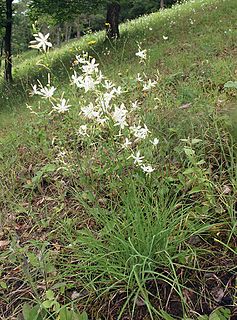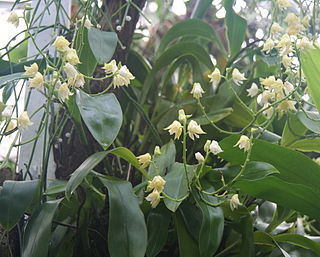Related Research Articles

Anthericum is a genus of about 65 species, rhizomatous perennial plants in the family Asparagaceae, subfamily Agavoideae. It was formerly placed in its own family, Anthericeae. The species have rhizomatous or tuberous roots, long narrow leaves and branched stems carrying starry white flowers. The members of this genus occur mainly in the tropics and southern Africa and Madagascar, but are also represented in Europe.

Polystachya, abbreviated Pol in horticultural trade, and commonly known as yellowspike orchid, is a flowering plant genus in the orchid family (Orchidaceae). This rather distinctive genus was described by William Jackson Hooker in 1824 and is the type genus of the subtribe Polystachyinae. It contains about 100 species widespread across many of the tropical areas of the world.
Vriesea longiscapa is a plant species in the genus Vriesea.

Hylomyrma is a genus of ants within the subfamily Myrmicinae. To date it contains 13 known species.

Melanopolia is a genus of longhorn beetles of the subfamily Lamiinae, containing the following species:
Microcacia is a genus of longhorn beetles of the subfamily Lamiinae, containing the following species:
Iris longiscapa is a plant species in the genus Iris, it is also in the subgenus Iris and in the section Hexapogon. It is a rhizomatous perennial from the deserts of Kazakhstan, Tajikistan, Turkmenistan and Uzbekistan. They have grass-like leaves and lilac-violet or blue-purple flowers on a tall slender stem.
Melanopolia brevicornis is a species of beetle in the family Cerambycidae. It was described by Dillon and Dillon in 1959.
Melanopolia cotytta is a species of beetle in the family Cerambycidae. It was described by Dillon and Dillon in 1959.
Melanopolia freundei is a species of beetle in the family Cerambycidae. It was described by Dillon and Dillon in 1959.
Melanopolia lysida is a species of beetle in the family Cerambycidae. It was described by Dillon and Dillon in 1959.
Melanopolia catori is a species of beetle in the family Cerambycidae. It was described by Karl Jordan in 1903.

Melanopolia cincta is a species of beetle in the family Cerambycidae. It was described by Karl Jordan in 1903. It is known from Equatorial Guinea, Cameroon and Gabon. It contains the varietas Melanopolia cincta var. maculata.

Melanopolia frenata is a species of beetle in the family Cerambycidae. It was described by Henry Walter Bates in 1884. It is known from Gabon and the Democratic Republic of the Congo.
Melanopolia ligondesi is a species of beetle in the family Cerambycidae. It was described by Lepesme in 1952.
Melanopolia ruficornis is a species of beetle in the family Cerambycidae. It was described by Stephan von Breuning in 1955.
Melanopolia gripha is a species of beetle in the family Cerambycidae. It was described by Karl Jordan in 1894, originally under the genus Monohammus. It is known from Gabon, Cameroon, and the Democratic Republic of the Congo.
Monochamus farinosus is a species of beetle in the family Cerambycidae. It was described by Henry Walter Bates in 1884, originally under the genus Melanopolia. It is known from Gabon.
Microcacia longiscapa is a species of beetle in the family Cerambycidae. It was described by Stephan von Breuning in 1939. It is known from Borneo.
Carbinea is a genus of Australian sheetweb spiders that was first described by V. T. Davies in 1999.
References
- ↑ BioLib.cz - Melanopolia longiscapa. Retrieved on 8 September 2014.
| This Lamiini article is a stub. You can help Wikipedia by expanding it. |